In my recent review of the Taurus Judge Public Defender, I demonstrated its performance relative to another popular pistol. Now, before rehashing that, let’s just ask a simple question:
Which would you expect to be more powerful?
- A .45 ACP pistol with a 3.3″ barrel
- A .45 Colt pistol with a 2″ barrel
Seems like an easy question, doesn’t it? I mean, seems like a complete no-brainer: obviously, to any reasonable person, the 3.3″ barrel is going to produce higher velocities than the 2″ barrel, right?
Well, yes.
And no. Not when the 2″ barrel is on a Judge.
And that’s where it gets fun, when theory meets testing (and testing always wins!)
Now, in reality it is a well-established axiom of ballistics that longer barrels = higher velocity, up to a point. The longer the barrel is, the more distance the bullet will travel while still being contained in the sealed environment of the barrel, and that means the expanding gases from the burning gunpowder can push on the bullet longer, thus increasing its velocity. This is all obvious and well-understood. And the knock against a short barrel has always been that it’s possible for the bullet to exit the barrel before the expanding gases have fully expanded, so any further expansion they do will be out into the atmosphere and not pressing against the bullet. Accordingly, really short barrels have usually been pretty bad at generating decent velocities. And an inch or two can make either a significant difference, or a miniscule difference; it really depends on where the barrel length difference comes in. The difference between a 6″ barrel and an 8″ barrel might be minor, but the difference between a 1″ barrel and a 3″ barrel will be huge! In the longer 6″ barrel the expanding gases may have done most of their job pushing the bullet by the time that bullet exits the barrel; there may not be much more that will be gained from the 8″ barrel. However, on a 1″ barrel, the gases very likely will have just barely have started expanding by the time the bullet pops out of that tiny barrel! Any further expansion is just wasted.
And yet — I’ve just completed testing on the Judge Public Defender (2″ barrel) against the Springfield XDS (3.3″ barrel) and found them to deliver almost identical velocities when shooting identical-weight bullets loaded to the same ballistic performance. How is this possible?
Barrel Lengths Are Measured Differently
The first key to understanding this mystery is to recognize that not all barrels are measured the same. The official barrel-measuring technique for rifles, shotguns, and semi-automatic pistols is to run a dowel down the barrel until it reaches the breech face (or where the back of the loaded cartridge would be); mark the dowel at that point, and then pull it out and measure it.
Using that technique with the Springfield XDS, we find that the marked dowel matches 3.3″, exactly what it should.
But with a revolver, that’s not how a barrel is measured! With a revolver, you only measure from the front of the revolver to the back of the barrel’s forcing cone. You don’t include any part of the cylinder. Measuring the Public Defender’s barrel in this way, we get exactly what we’d expect: 2″, just like the printed specifications say it should be.
And yet — when we stack the two pistols back to back, we see that they’re pretty much the same size, right?
And when we compare the ballistics, we find that they perform almost identically: Critical Defense 185 grain produces 870 feet per second from the 2″ Public Defender, and 901 feet per second from the 3.3″ XDS. And with “hot” loads shooting 200 grains at the highest pressure and fastest speeds I could find, the 2″ Public Defender shot at 940 feet per second, and the XDS shot at 970 feet per second. That’s a difference of about 3%, while the XDS’s barrel length is 65% longer than the Public Defender. How is this possible? How is the Public Defender delivering comparable performance, from a barrel that’s barely over half as long?
It’s The Cylinder, Silly!
Look at this picture of the Public Defender, and what stands out about it?
That giant cylinder, right? When you hear criticisms of the Judge, frequently the cylinder will be mentioned as a drawback because it’s what makes the gun so big. Interestingly enough, it’s also what makes the gun so much more powerful than you would otherwise expect!
Understand that with any revolver, the fact that they measure the barrel without including the chamber means that you’ll always have more performance from a revolver than you would from a semiautomatic of the exact same barrel length (because some of the semiauto’s barrel length is occupied by the bullet.) But in the Judge, it’s even more of a difference. Here’s a picture that shows the Public Defender with a .45 Colt bullet overlaid.
You can see that there’s about an inch of “free bore” from the end of the bullet to the start of the forcing cone. My actual measurement was 1 1/8″. How does that “free bore” affect the ballistic performance? Basically it adds another inch of “barrel length.” So, yes, in effect, any 2.5″-cylinder Judge actually has the ballistic performance of a gun with an inch longer barrel than it says it is, and any 3″-cylinder judge performs like a gun with a 1.5″ longer barrel than it’s rated as!
Verifying The Hypothesis
My hypothesis is that ballistically, the “free bore” area is basically extra unrifled barrel. The bullet doesn’t “know” whether it’s technically in the “barrel” or not; it just knows that it’s trapped in a sealed environment and that there are gases pushing against the back of it (and, okay, it doesn’t “know” that either, but I think you get what I’m saying). So whether the bullet is in the rifled “barrel” part or still in the freebore of the cylinder, it’s still in a sealed environment, being pushed forward by expanding gases, rifling or not. That additional time spent with the gases expanding results in additional velocity, exactly like a longer barrel would have. Whether it’s labeled “barrel” or “cylinder”, the result is the same.
This idea seems reasonable, but I wanted to take it a step further and actually test a 2″-barrel .45 Colt pistol against a 2″-barrel Judge, to see if there was a real-world, measurable difference in performance. While 2″-barrel .45 Colt pistols do exist, they’re not easy to find, and I was unable to source one; however, I was able to do the next best thing: I went to www.ballisticsbytheinch.com and looked up their performance results for .45 Colt rounds, and found that in the “real world weapons” section, they had indeed tested a 2″ .45 Colt (the Taurus 450 Ultralight). Using Federal 225-grain Semi-Wadcutter Hollow Point rounds, they got an average velocity of 681 feet per second from the 2″-barrel Taurus 450. So I went and chronographed that exact same round out of the 2″-barrel Public Defender and got … drum roll… 844 feet per second! A huge performance increase; the velocity was almost 25% faster out of the Judge Public Defender’s 2″ barrel, than it was from the Taurus 450’s 2″ barrel. Since the barrel length was identical (and probably was the same barrel, seeing as they’re from the same manufacturer), then what could account for the difference? Only the longer cylinder.
The net result is: for a Judge with a 2.5″ cylinder, you’re getting about an inch extra performance than you might otherwise have thought. And for a Judge with a 3″ cylinder, you’re getting about 1.5″ extra performance. A 3″-barrel, 2.5″-cylinder Judge will perform about as well as a 4″-barrel .45 Colt revolver. And a 3″-barrel, 3″-cylinder Magnum Judge will perform about as well as 4.5″-barrel .45 Colt revolver.
Now, what about when used as a shotgun? Here, the additional barrel length advantage is even more significant. Because a shotgun is typically measured back to the breech face, in order to get comparable measurements with the Judge we’d have to measure back to the breech face.
That’s almost 4 and three quarters inches; and that means that on the Judge Public Defender, it performs about comparably to a .410 shotgun with a 4.75″ barrel. That’s still tiny, but it’s a darn sight better than a 2″ barrel! And when you get into the longer-barreled Judges, the shotgun performance starts to get downright respectable: a 6.5″ barrel Raging Judge Magnum, with a 3″ chamber, is about effectively equivalent of a 9.5″ shotgun barrel. That’s not huge, but it’s pretty darn substantial.
So, take heart, Judge users: the cylinder giveth (performance), and it taketh away (compactness). But that big old cylinder isn’t “wasted space”, it’s actually working to make your pistol more powerful than you thought it was.

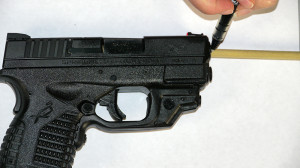
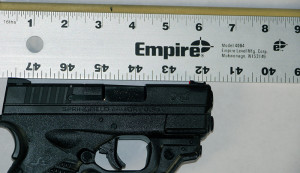
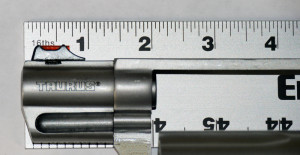
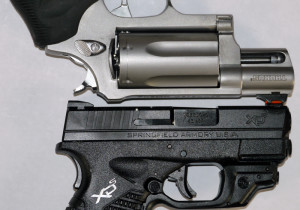
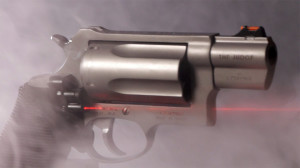

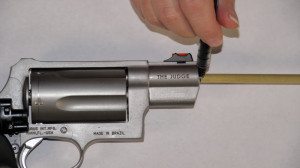
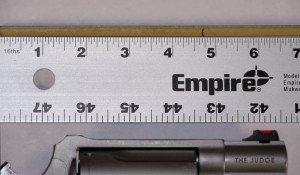

Pingback: Why the Judge is more powerful than you think...
Unblinkingeye.com has a Taurus 450 review by Ed Buffaloe that might interest you. He chronographed Horniday critical Defense at 839FPS. He chronographed Winchester Silver Tips as well.
Always figured as much, nice to see some research behind the theory.
Um…no. You feel comfortable carrying it, more power to you. The 45 XDS is every bit as powerful as the judge. Noticed you didn’t test any .45 acp in the XDS against it. Speer makes a short barrel 45 acp load. 230 grain at 820 fps out of a 3.25″ barrel. Not more powerful.
Plus let’s also compare the width of the two. The judge at 1.5″ and the XDS at 1″ even. 50% narrower.
I just bought one since I’ve heard so much about them. Thanks for all this great info.This is the fourth heavy hitter I have added to my collection.
Good article. There is another point to be made about semi-auto vs. pistol barrel length comparisons. A gap exists between the cylinder and forcing cone in revolvers. Expanding gasses escape through this gap (keep your support hand thumb away from this area when shooting). Loss of gas pressure here results in a loss of velocity. So the combined barrel and cylinder length of a revolver is not “the same” as a continuous barrel of the same length. Close, maybe. But it depends on the revolver’s design.
True. BallisticsByTheInch.com attempted to quantify how much velocity is lost through the gap, here: http://ballisticsbytheinch.com/gaptests.html
Great articles on the Judge series of revolvers. Couple of questions:
1. Have you actually chronographed a Public Defender (steel or polymer) ( 2.5 inch cylinder, 2 inch barrel); a standard Judge (2.5 inch cylinder, 3 inch barrel); and a magnum Judge (3 inch cylinder, 3 inch barrel) using the same .45 Colt ammunition (and maybe varying the variety (not challenging, just asking)? As I understand you, a 2 or 3 inch judge should shoot slightly faster than a comparable dedicated .45 Colt revolver. In other words, the increased freebore is “good” for velocity.
2. Does the increased freebore SIGNIFICANTLY affect practical accuracy, vs. that of a dedicated .45 Colt?
3. Bottom line: If I’m trying to decide on a 2.5 inch cylinder vs. a 3 inch cylinder Judge, other than the size and weight differences, and price differences-the obvious things-is there anything to recommend the smaller cylinder over the larger cylinder? Some other performance or reliability or durability differences (not for CC use; house or vehicle or trail or general SD uses)?
4. For that matter, is there much to be lost to using one of the 2 inch barrel PD models (other than the .410 shell flexibility) for general personal defense, NOT CC). OK, more than “a couple of questions”!